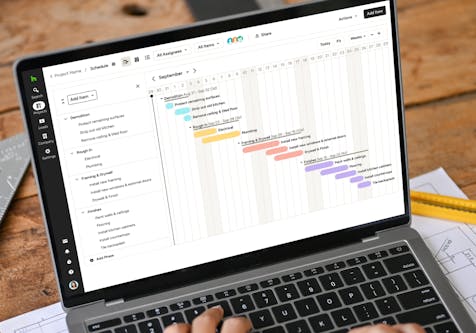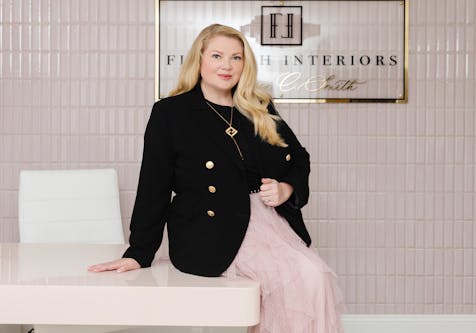Navigating Client Discounts in the Interior Design Industry
How to decide if offering reductions is right for your firm.

The topic of offering client discounts can be a divided one among interior designers. As design pros, you work hard to bring homeowners’ design dreams to life and have the skills, experience and education to do so. Why would you assign a reduced value to the work you do?
Can offering some types of discounts make your firm more competitive and sustainable over time? In this article, we aim to present a more nuanced discussion around considering and addressing discounts to help you decide what approach and pricing structure works best for your interior design business and circumstances.
We explore common client discounts, how to decide if leveraging them is right for your organization, and offer advice from other pros on how they approach their discount strategy.

Why Clients Request Discounts
Let’s start with exploring some of the reasons clients may seek a reduction. While it is easy to assume that requests emerge from a sense of entitlement, the reality is likely more complex. Here are some possible motives:
1. Opportunity
Many customers assume that the price of everything is inflated and assume there is always wiggle room. They may have been taught to never buy a car for the sticker price. They view successful bargaining as a victory.
2. Distrust
Related to these assumptions is a concern that they may be taken advantage of. They think the interior designer is reaping the benefits of deep discounts and not sharing them.
3. Tight Budget
A client simply may have extremely limited resources, but they really like your design team, and their vision. A small discount might mean they can still retain your services without breaking the bank.
4. They Cannot Afford Your Firm
It could be a case of a homeowner simply having rich tastes, but less means to pay for the luxury. In those cases, even the deepest discounts won’t solve the issue.

The Pros & Cons of Offering Discounts
A Strategic Discount Approach
While some designers see discounts as a tangible way to show clients the savings their company offers, others see the practice as a slippery slope that devalues their expertise and services.
Vanessa C. Smith, owner and lead designer of Flourish Interiors says her company avoids blanket discounts, but does offer reductions in a more limited and nuanced way. Her firm offers discounts for first-time clients or during a slower month, for example. “Offering discounts is a strategic method for increasing our market share and business success at Flourish Interiors,” she says of her Indiana-based business.
Her approach balances the risks to the firm with the benefits of increasing its client base. “The goal is to offer a limited opportunity to protect the business and the potential exposure of the discounting, but also help encourage potential clients to start working with us,” she says. After clients are on board, they are less likely to seek more reductions because they understand the value and expertise they are receiving. “We find that once clients get going, they really see the value in what a full service, experienced designer can bring to their project,” she says.
Passing on discounts to clients has the advantage of helping designers provide full transparency of the process. And doing so, can make it less likely that they will question the budget every step along the way during the project journey. With Houzz Pro software, if you would like to provide your client with a discount on a line item or on the total project cost, you can easily do so. Learn here how to apply subtotal discounts.

Minimizing Discounts, Maximizing Value
Some designers are not keen on risking the erosion of their profit margins by passing discounts on to clients that they have worked so diligently to acquire. “I feel like as designers we work very hard to create relationships, adhere to purchasing minimums, discover amazing vendors and our hard work and connections are a big part of the reason clients are hiring us,” interior designer Jena Bula says.
Product markup is part of the business model and strategy of her company Delphinium Design, she says. However, Bula sets limits on that markup to provide her clients a fair and equitable pricing structure. “One thing I do feel strongly about, is that we do not mark products up past MSRP,” she says. “What a client would pay for a product if they were to order themselves – though they can’t order directly from most of the vendors I source from – is what we charge them.”
In cases you would want to offer a discount on the MSRP after all, the Houzz Pro software offers a super clean way to display the discount on MSRP to clients, see here how to do it.
Alshie Garlie, owner of Welcome Home Staging in Maryland also keeps her discounts to a minimum. “Although I find it helpful in some businesses, such as retail, to offer some type of discount, I feel that giving away my time for free or at discounted rate discredits my expertise as a high-end designer,” she says. “I have found that giving away anything for free in the beginning, then becomes expected throughout the relationship with my clients and that is not a good fit for the WH brand. My time is valuable, and If my customers respect me, they will see the value in my services as well.”
She is mindful of her competitors, however, when it comes to her offerings. Since many designers typically provide a complimentary initial design consultation, she does the same. “As a hook to make my business stand out from the competition, I do offer a 15-minute complimentary virtual call which is crucial to get to know my potential clients, see what their dilemma and goals are, and to make sure that we are a good fit,” she says.
“A Customer Care Strategy”
Some designers prefer more customized discounts to fit specific circumstances through an invoice, or free shipping or product. “We use discounting on a custom basis as a strategic customer care practice,” Smith says. “When we feel like a client is reaching a pain point during a project, for example because of surprise expenses or timing delays which unfortunately are sometimes out of our control, I will often find ways to discount a current invoice, give them an upgrade for free, etc. to try and demonstrate our care for them,” she says. “Small discounts or incentives like this really make a big difference in customer experience,” she says.
Project-End Incentives Can Pay Off
Designers who make it their policy to retain their trade discounts, limit reductions to ensure that their profit margins allow for reinvestment into their firms, may decide to offer discounts at the end of the project instead.
One common discount to keep a steady revenue flow is to offer percentage reductions for early and up front payments. Many clients now prefer to pay through a safe, online method instead of the old-fashioned way of checks and money orders. Combining discounts with safe, easy online payment options is a recipe for getting paid earlier and more often. Here are some pro tips for creating a smooth payment process.
Using happy clients to fill the sales pipeline with referrals is another way incentives can work for designers. Garlie incentivizes repeat customers through a referral program.“I do have a referral program for my clients,” says Garlie. “A majority of my business is organically from referrals as my final product is 100% visual and 100% customer service,” she says. “When they leave happy, they are excited to share their home beautification journey.”
Whether you pass along trade discounts, offer breaks to new clients or offer no reductions, having a well thought out pricing policy in place before a client requests a discount will make it easier to handle their inquiries, and demonstrate that your firm’s approach is a fair and equitable one.
Learn more about how Houzz Pro software helps firms create the transparency level of their choosing with customers. Try a Houzz Pro free trial now.

Want advice delivered to your inbox?
Unlock industry insights and updates for contractors and design pros
By signing up, I agree to the Houzz Terms of Use and Privacy Policy and that Houzz may use my information to contact me about relevant content, products, and services.













Join the conversation by commenting or asking a question below. The Houzz team reads every single comment, and we’ll get back to you by email if you need us!